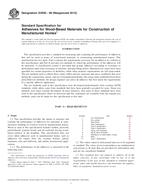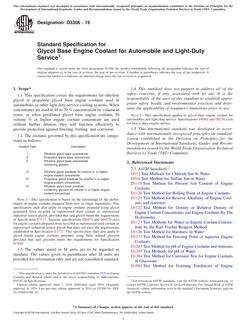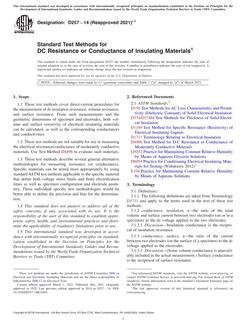Click here to purchase
<div class=”SectionLevel2″> <p class=”subsec1 cdone2″><a name=”s00002″></a><span class=”Head3 cdone”>1.1</span> This practice covers requirements for the validation of measurements made by laboratory or process (online or at-line) near- or mid-infrared analyzers, or both, used in the calculation of physical, chemical, or quality parameters (that is, properties) of liquid petroleum products and fuels. The properties are calculated from spectroscopic data using multivariate modeling methods. The requirements include verification of adequate instrument performance, verification of the applicability of the calibration model to the spectrum of the sample under test, and verification that the degree of agreement between the results calculated from the infrared measurements and the results produced by the PTM used for the development of the calibration model meets user-specified requirements. Initially, a limited number of validation samples representative of current production are used to do a local validation. When there is an adequate number of validation samples with sufficient variation in both property level and sample composition to span the model calibration space, the statistical methodology of Practice <a name=”refa00006″></a><a href=”/SUBSCRIPTION/NewValidateSubscription.cgi?D6708-HTML”><span class=”Body-link1 cdone”>D6708</span></a> can be used to provide general validation of this equivalence over the complete operating range of the analyzer. For cases where adequate property and composition variation is not achieved, local validation continues to be used.</p> <div class=”SectionLevel3″> <p class=”subsec2 cdone2″><a name=”s00256″></a><span class=”Head4 cdone”>1.1.1</span> For some applications, the analyzer and PTM are applied to the same material. The application of the multivariate model to the analyzer output (spectrum) directly produces a PPTMR for the same material for which the spectrum was measured. The PPTMRs are compared to the PTMRs measured on the same materials to determine the degree of agreement.</p></div> <div class=”SectionLevel3″> <p class=”subsec2 cdone2″><a name=”s00257″></a><span class=”Head4 cdone”>1.1.2</span> For other applications, the material measured by the analyzer system is subjected to a consistent treatment prior to being analyzed by the PTM. The application of the multivariate model to the analyzer output (spectrum) produces a PPTMR for the treated material. The PPTMRs based on the analyzer outputs are compared to the PTMRs measured on the treated materials to determine the degree of agreement.</p></div></div> <div class=”SectionLevel2″> <p class=”subsec1 cdone2″><a name=”s00264″></a><span class=”Head3 cdone”>1.2</span> Multiple physical, chemical, or quality properties of the sample under test are typically predicted from a single spectral measurement. In applying this practice, each property prediction is validated separately. The separate validation procedures for each property may share common features, and be affected by common effects, but the performance of each property prediction is evaluated independently. The user will typically have multiple validation procedures running simultaneously in parallel.</p></div> <div class=”SectionLevel2″> <p class=”subsec1 cdone2″><a name=”s00265″></a><span class=”Head3 cdone”>1.3</span> Results used in analyzer validation are for samples that were not used in the development of the multivariate model, and for spectra which are not outliers or nearest neighbor inliers relative to the multivariate model.</p></div> <div class=”SectionLevel2″> <p class=”subsec1 cdone2″><a name=”s00266″></a><span class=”Head3 cdone”>1.4</span> When the number, composition range or property range of available validation samples do not span the model calibration range, a local validation is done using available samples representative of current production. When the number, composition range and property range of available validation samples becomes comparable to those of the model calibration set, a general validation can be done.</p> <div class=”SectionLevel3″> <p class=”subsec2 cdone2″><a name=”s00267″></a><span class=”Head4 cdone”>1.4.1</span> <span class=”Head4Title cdone”>Local Validation: </span></p><div class=”SectionLevel4″> <p class=”subsec3 cdone2″><a name=”s00268″></a><span class=”Head5 cdone”>1.4.1.1</span> The calibration samples used in developing the multivariate model must show adequate compositional and property variation to enable the development of a meaningful correlation, and must span the compositional range of samples to be analyzed using the model to ensure that such analyses are done via interpolation rather than extrapolation. The Standard Error of Calibration (SEC) is a measure of how well the PTMRs and PPTMRs agree for this set of calibration samples. SEC includes contributions from spectrum measurement error, PTM measurement error, and model error. Sample (type) specific biases are a part of the model error. Typically, spectroscopic analyzers are very precise, so that spectral measurement error is small relative to the other types of error.</p></div><div class=”SectionLevel4″> <p class=”subsec3 cdone2″><a name=”s00269″></a><span class=”Head5 cdone”>1.4.1.2</span> During initial analyzer validation, the compositional range of available samples may be small relative to the range of the calibration set. Because of the high precision of the spectroscopic measurement, the average difference between the PTMRs and PPTMRs may reflect a sample (type) specific bias which is statistically observable, but which are less than the 95 % uncertainty of PPTMR, <span style=”font-style:italic;font-weight:normal;” class=”overriddenformat”>U(PPTMR)</span>. Therefore, the bias and precision of the PTMR/PPTMR differences are not used as the basis for local validation.</p></div><div class=”SectionLevel4″> <p class=”subsec3 cdone2″><a name=”s00270″></a><span class=”Head5 cdone”>1.4.1.3</span> Based on SEC, and the leverage statistic, a 95 % uncertainty for each PPTMR, <span style=”font-style:italic;font-weight:normal;” class=”overriddenformat”>U(PPTMR)</span> is calculated. During validation, for each non-outlier sample, a determination is made as to whether the absolute difference between PPTMR and PTMR, |”†|, is less than or equal to <span style=”font-style:italic;font-weight:normal;” class=”overriddenformat”>U(PPTMR)</span>. Counts are maintained as to the total number of non-outlier validation samples, and the number of samples for which |”††| is less than or equal to <span style=”font-style:italic;font-weight:normal;” class=”overriddenformat”>U(PPTMR)</span>. Given the total number of non-outlier validation samples, an inverse binomial distribution is used to calculate the minimum number of results for which |”†| must be less than <span style=”font-style:italic;font-weight:normal;” class=”overriddenformat”>U(PPTMR)</span>. If the number of results for which |”| is less than <span style=”font-style:italic;font-weight:normal;” class=”overriddenformat”>U(PPTMR)</span> is greater than or equal to this minimum, then the results are consistent with the expectations of the multivariate model, and the analyzer passes local validation. The calculations involved are described in detail in Section <a href=”#s00157″><span class=”Body-link1 cdone”>11</span></a> and <a href=”#an00120″><span class=”Body-link1 cdone”>Annex A4</span></a>.</p></div><div class=”SectionLevel4″> <p class=”subsec3 cdone2″><a name=”s00271″></a><span class=”Head5 cdone”>1.4.1.4</span> The user must establish that results that are consistent with the expectations based on the multivariate model will be adequate for the intended application. A 95 % probability is recommended for the inverse binomial distribution calculation. The user may adjust this based on the criticality of the application. See <a href=”#an00120″><span class=”Body-link1 cdone”>Annex A4</span></a> for details.</p></div></div> <div class=”SectionLevel3″> <p class=”subsec2 cdone2″><a name=”s00272″></a><span class=”Head4 cdone”>1.4.2</span> <span class=”Head4Title cdone”>General Validation: </span></p><div class=”SectionLevel4″> <p class=”subsec3 cdone2″><a name=”s00273″></a><span class=”Head5 cdone”>1.4.2.1</span> When the validation samples are of sufficient number, and their compositional and property ranges are comparable to that of the model calibration set, then a General Validation can be done.</p></div><div class=”SectionLevel4″> <p class=”subsec3 cdone2″><a name=”s00274″></a><span class=”Head5 cdone”>1.4.2.2</span> General Validation is conducted by doing a <a name=”refa00006″></a><a href=”/SUBSCRIPTION/NewValidateSubscription.cgi?D6708-HTML”><span class=”Body-link1 cdone”>D6708</span></a> based assessment of the differences between results from the analyzer system (or subsystem) produced by application of the multivariate model, (such results are herein referred to as PPTMRs), versus the PTMRs for the same sample set. The calculated precision and bias are statistically compared to user- specified requirements for the analyzer system application.</p></div></div> <div class=”SectionLevel3″> <p class=”subsec2 cdone2″><a name=”s00378″></a><span class=”Head4 cdone”>1.4.3</span> For analyzers used in product release or product quality certification applications, the precision and bias requirement for the degree of agreement are typically based on the site or published precision of the PTM.</p></div> <div class=”SectionLevel3″> <p class=”subsec2 cdone2″><a name=”s00379″></a><span class=”Head4 cdone”>1.4.4</span> This practice does not describe procedures for establishing precision and bias requirements for analyzer system applications. Such requirements must be based on the criticality of the results to the intended business application and on contractual and regulatory requirements. The user must establish precision and bias requirements prior to initiating the validation procedures described herein.</p><div style=”text-align:left;” class=”NoteLevel2″><a name=”n00001″></a> <p><span class=”note cdone” style=”text-transform: uppercase;”>Note 1:</span> <span class=”note cdone”>In most applications of this type, the PTM is the specification-cited test method.</span></p></div></div></div> <div class=”SectionLevel2″> <p class=”subsec1 cdone2″><a name=”s00006″></a><span class=”Head3 cdone”>1.5</span> This practice does not cover procedures for establishing the calibration model (correlation) used by the analyzer. Calibration procedures are covered in Practices <a name=”refa00012″></a><a href=”/SUBSCRIPTION/NewValidateSubscription.cgi?E1655-HTML”><span class=”Body-link1 cdone”>E1655</span></a> and references therein.</p></div> <div class=”SectionLevel2″> <p class=”subsec1 cdone2″><a name=”s00007″></a><span class=”Head3 cdone”>1.6</span> This practice is intended as a review for experienced persons. For novices, this practice will serve as an overview of techniques used to verify instrument performance, to verify model applicability to the spectrum of the sample under test, and to verify equivalence between the parameters calculated from the infrared measurement and the results of the primary test method measurement.</p></div> <div class=”SectionLevel2″> <p class=”subsec1 cdone2″><a name=”s00008″></a><span class=”Head3 cdone”>1.7</span> This practice teaches and recommends appropriate statistical tools, outlier detection methods, for determining whether the spectrum of the sample under test is a member of the population of spectra used for the analyzer calibration. The statistical tools are used to determine if the infrared measurement results in a valid property or parameter estimate.</p></div> <div class=”SectionLevel2″> <p class=”subsec1 cdone2″><a name=”s00009″></a><span class=”Head3 cdone”>1.8</span> The outlier detection methods do not define criteria to determine whether the sample or the instrument is the cause of an outlier measurement. Thus, the operator who is measuring samples on a routine basis will find criteria to determine that a spectral measurement lies outside the calibration, but will not have specific information on the cause of the outlier. This practice does suggest methods by which instrument performance tests can be used to indicate if the outlier methods are responding to changes in the instrument response.</p></div> <div class=”SectionLevel2″> <p class=”subsec1 cdone2″><a name=”s00010″></a><span class=”Head3 cdone”>1.9</span> This practice is not intended as a quantitative performance standard for the comparison of analyzers of different design.</p></div> <div class=”SectionLevel2″> <p class=”subsec1 cdone2″><a name=”s00011″></a><span class=”Head3 cdone”>1.10</span> Although this practice deals primarily with validation of infrared analyzers, the procedures and statistical tests described herein are also applicable to other types of analyzers which employ multivariate models.</p></div> <div class=”SectionLevel2″> <p class=”caveat cdone2″><a name=”s00012″></a><span class=”Head3 cdone”>1.11</span> <i>This standard does not purport to address all of the safety concerns, if any, associated with its use. It is the responsibility of the user of this standard to establish appropriate safety, health, and environmental practices and determine the applicability of regulatory limitations prior to use.</i></p></div> <div class=”SectionLevel2″> <p class=”WTOcaveat cdone2″><a name=”s00275″></a><span class=”Head3 cdone”>1.12</span> <i>This international standard was developed in accordance with internationally recognized principles on standardization established in the Decision on Principles for the Development of International Standards, Guides and Recommendations issued by the World Trade Organization Technical Barriers to Trade (TBT) Committee.</i></p></div>
Product Details
- Published:
- 07/01/2018
- Number of Pages:
- 44
- File Size:
- 1 file , 1000 KB
- Redline File Size:
- 2 files , 2.6 MB


